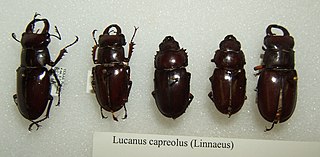
Stag beetles are a family of about 1,200 species of beetles in the family Lucanidae, currently classified in four subfamilies. Some species grow to over 12 centimetres, but most to about 5 cm (2 in).

Scarabaeoidea is a superfamily of beetles, the only subgroup of the infraorder Scarabaeiformia. Around 35,000 species are placed in this superfamily and some 200 new species are described each year. Its constituent families are also undergoing revision presently, and the family list below is only preliminary. This superfamily includes some of the largest beetles extant today, including rhinoceros beetles, (Dynastinae), the Hercules beetle and Goliath beetles.

Prostomidae is a family of beetles with no vernacular common name, though recent authors have coined the name jugular-horned beetles. They are often found in dead wood. The family consist of two extant genera with about 20 species. Prostomis americanus is known from North America. Other species of Prostomis are found in Europe, Africa, the Pacific region and East Asia. Species of Dryocora are known from New Zealand, Australia and Tasmania.

The Chrysomelinae are a subfamily of leaf beetles (Chrysomelidae), commonly known as broad-bodied leaf beetles or broad-shouldered leaf beetles. It includes some 3,000 species around the world.

Lucanus cervus, known as the European stag beetle, or the greater stag beetle, is one of the best-known species of stag beetle in Western Europe, and is the eponymous example of the genus. L. cervus is listed as Near Threatened by the IUCN Red List.

Lucanus capreolus, the reddish-brown stag beetle or pinching beetle, is a beetle of the family Lucanidae. The specific name capreolus is derived from Latin, meaning "roe deer". The name refers to the resemblance of the mandibles to deer antlers.

Phalacrognathus muelleri, colloquially known as the rainbow stag beetle, and also the king, magnificent or Mueller's stag beetle, is a species of beetle in the family Lucanidae. It is found in northern Queensland, Australia and New Guinea. It can come in red, green, black, and blue forms. It is the only species in its genus, Phalacrognathus, which is closely related to the genus Lamprima.

Phloeodes diabolicus, common name: diabolical ironclad beetle, or Evil Bug is a beetle of the family Zopheridae. It is native to the California Floristic Province in the states of California and Baja California, where it is believed to eat fungi growing under rotting tree bark. It is flightless and has a remarkably long adult lifespan of eight years, compared to the weeks or months of most adult beetle lifespans.

Ryssonotus nebulosus is a beetle of the family Lucanidae, and the sole member of the genus Ryssonotus. It is found in Queensland and New South Wales, Australia.
The Lucanidae are a family of beetles that include the stag beetles. The family can be further subdivided in a taxonomy. The classification presented here follows Smith (2006), with the exception of the tribal classification within the Lucaninae.
Trachelostenus is a genus of darkling beetles in the family Tenebrionidae. It is native to the Valdivian forests of Chile, and has at least two species, T. inaequalis (Solier) and T. fascicularis (Philipp). It was historically considered the only member of the family Trachelostenidae, but a 2015 study sunk the genus into the tenebrionid subfamily Tenebrioninae.

The Ulodidae are a family of beetles belonging to Tenebrionoidea. They are native to the Southern Hemisphere, with species found in Australia, New Zealand, New Caledonia and Chile. Larvae and adults are generally found on dead wood or fungus associated with rotting wood, and are mycophagous. There are approximately 40 species in 16 genera.

Platycerus caraboides is a species of stag beetle belonging to the family Lucanidae, subfamily Lucaninae.

Lamprima aurata, the golden stag beetle, is a species of beetle in the family Lucanidae. In Tasmania, this species is referred to by the common name of Christmas beetle, a name that is normally used for beetles in the family Scarabaeidae, genus Anoplognathus.

Paralissotes reticulatus, also called the New Zealand reticulate stag beetle, is a native species of stag beetle from New Zealand. Although they do have wings they are flightless.

Geodorcus helmsi, known as New Zealand giant stag beetle or Helms's stag beetle, is a large, slow-moving, flightless stag beetle in the family Lucanidae. It is endemic to New Zealand.

Iphthiminus is a genus of darkling beetles in the subfamily Tenebrioninae.
Safrina is a genus of stag beetles that are endemic to Australia.

Aegus is a genus of stag beetles in the family Lucanidae. Comprising about 260 species in the genus, they are placed in the largest subfamily Lucaninae. They are distributed in South Asia, Southeast Asia and the Pacific countries, but introduced accidentally to many parts of the islands.















